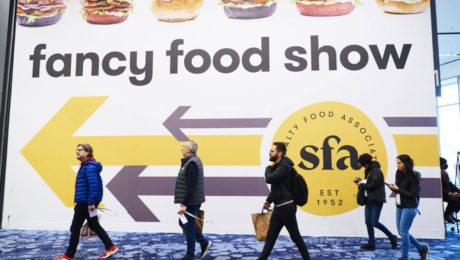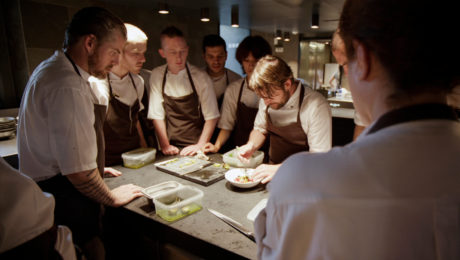Sourdough Fermentation & Gut Health
Sourdough is being researched for its effectiveness in helping people with celiac disease and gluten sensitivities. Charlene Van Buiten, PhD, an assistant professor of food science and human nutrition at Colorado State University, shared how sourdough can alleviate problems with gut health in an article she wrote for Baking Europe.
The live, active cultures contained in fermented foods like kimchi, pickles, kombucha and yogurt have been scientifically proven to increase the diversity of microorganisms in the digestive tract. A recent study from researchers at Stanford found a diet rich in fermented foods decreases markers of inflammation.
The same health benefits cannot be attributed to sourdough, though, because the live microorganisms are killed during baking.
“As a result, the health benefits associated with sourdough bread are derived not from probiotics, but from the actions of the starter culture over the course of fermentation,” Van Buiten writes. The microorganisms present in starter cultures “have been shown to improve mineral bioavailability in sourdough bread in comparison to conventional yeast-fermented bread through the production of organic acids and enzyme phytase, which promote the degradation of anti-nutritional phytates found naturally in flour. “
Sourdough bread has other positive effects, too. The increased acidity of sourdough forms resistant starch, so starch is not converted to sugar by the gastrointestinal tract but instead “acts more like fiber.” Sourdough fermentation also increases the amount of free amino acids in bread, improving the protein digestibility. Sourdough bread made from starter cultures are also lower on the glycemic index.
Van Buiten points out case studies “have suggested that traditional sourdough fermentation can improve gastrointestinal tolerance to bread in comparison to conventional yeast fermentation,” but only for individuals with non-celiac gluten sensitivity. Few studies have explored how sourdough would impact someone with celiac. A study would need to explore gluten degradation within sourdough fermentation, a key sensitivity for individuals with celiac.
“Though no evidence currently exists where traditional artisanal sourdough fermentation provides protection against the harmful gluten peptides associated with celiac disease pathogenesis, scientists are exploring novel strategies to employ the known gluten-degrading capabilities of sourdough-derived microorganisms in the production of baked goods,” Van Buiten adds.
Read more (Baking Europe)
Japan Turns to Fermented Foods for Food Waste Solution
In Japan, more and more food producers are turning to fermentation as a cost-effective and nutritious way to give new life to food waste. It comes at a critical time, as the Japanese government has made an ambitious plan to halve food waste by 2030.
Fermentation has deep-rooted tradition in Japan, where kōji-based products like miso and sake were first made centuries ago (pictured, students in a miso class mix soybeans with kōji rice and salt). Japan Times outlines how Japanese producers are experimenting with fermentation to combat climate change:
- For example, multiple Japanese beermakers are using food scraps in their brewing. Chiba Upcycling Lab is using bread waste, Rise & Win brewery uses yuzu peel and Ashai uses spent coffee grounds.
- The Japan Food Ecology Center produces pig feed using lactic acid bacteria to ferment 39 metric tons of food scraps a day that come from 180 businesses.
- Tokyo-based Food Alchemist Lab is making plant-based salami using kōji, nuts and vegetable fibers, including juice production scraps.
Key is “combining ancient fermentation knowledge with novel approaches,” the article continues.
“Microorganisms have given us miso, sake and soy sauce. Now they can help save the planet,” says Tomas Linder, associate professor and senior lecturer in microbiology at the Swedish University of Agricultural Sciences in Uppsala.
Read more (Japan Times)
- Published in Business, Food & Flavor
San-J “Aims to Make the U.S. a Fermentation Destination”
San-J Tamari brings a unique twist in the U.S. to Asian sauces. Tamari, a byproduct of miso paste production, is a smaller subcategory of soy sauce. Tamari is made strictly from soybeans rather than the 1:1 ratio of soy and wheat used in soy sauce. And San-J’s president, Takashi Sato, envisions growing the Virginia-based brand to support the larger fermentation industry.
Sato is the 8th generation of the Sato family to lead San-J production. The Sato family founded San-Jirushi, San-J’s parent company, in Mie, Japan in 1804. They officially opened facilities in the U.S. in 1974, America’s first tamari brewing facility. Launching the brand in the U.S. in the ‘70s was an ideal time as the counterculture movement of the ‘60s was winding down. San-J was able to stand apart from major soy sauce brands because they don’t use coloring in their sauces. Chefs say the gluten-free, kosher, non-GMO standards of San-J tamari product is a big draw when looking for sauces. It’s flavor is also more intense.
“When we wanted to differentiate ourselves from Kikkoman, we noticed and focused on hippie culture in the United States since it was still active when we opened our office in 1978,” Sato says. “Taking the concept of hippie, we wanted to exclude all the additives and to make it natural.”
Sato has a bigger vision for San-J, hoping to help grow and support the fermentation industry. He wants to create a larger market through education. Sato spoke at TFA’s conference, FERMENTATION 2022. He also hosted a series of ticketed workshops last fall that included factory tours, fermented food tasting DIY miso kits and one-on-one “genius bar” sessions. He plans to host a second symposium later this year.
He’s also partnered with other fermentation scientists and educators to promote “fermentourisum” through the think tank and online platform Hakko Hub. Hakko means fermentation in Japanese.
“The demand for fermented foods isn’t strong enough in the U.S.,” Sato says. “In order to create demand, it’s important to create/stimulate interest in fermented foods.”
Read more (Richmond Magazine)
- Published in Business
Electric Kombucha
In the last few years, entrepreneurial scientists have found creative uses for the kombucha SCOBY mother used to make new products. The latest: using SCOBY as a malleable surface to print circuit boards.
Researchers at the University of the West of England, Bristol, discovered the dried mats made from the cellulose of the SCOBY make flexible, cheaper, lighter and more eco-friendly circuit boards for electronics. And because these kombucha mats are non-conductive, they’re also safer. Andrew Adamatzky, professor at the university and one of the researchers, says they tested the SCOBY mat with tiny LEDs on the circuits, which still worked after stress tests.
“Nowadays kombucha is emerging as a promising candidate to produce sustainable textiles to be used as eco-friendly bio wearables,” Adamatzky, tells New Scientist. “We will see that dried — and hopefully living — kombucha mats will be incorporated in smart wearables that extend the functionality of clothes and gadgets. We propose to develop smart eco-wearables which are a convergence of dead and alive biological matter.”
Researchers hope kombucha electronics can soon be used as wearable electronics, like heart rate monitors.
The discovery is another in a unique lineup of SCOBY-based innovations. Alternative “leather” closes made from SCOBY were designed by an Iowa State professor in 2016, SCBOY water purifiers were designed by a Massachusetts Institute of Technology and Imperial College London scientists in 2021 and a SCOBY wood alternative called Pyrus was designed by University of Illinois student in 2021.
Read more (ARS Technica)
- Published in Science
Bringing Injera to U.S. Diners
A California-based Ethiopian chef is making some creative takeout offerings. Serkaddis Alemu of Santa Barbara Ethiopian restaurant Petit Valentien now sells DIY injera kits, for customers to create the fermented flatbread at home.
“Don’t call it bread; don’t call it crȇpes: Injera is injera,” Alemu says (pictured with her husband and daughters). “With fermentation, you really can’t cut corners.”
Injera is a spongy, sour, pancake-like flatbread. It is made of teff flour, a nutrient-dense flour that grows in the highlands of Ethiopia. Injera is a staple in Ethiopia, and TFA predicts it’s poised to become a popular fermented food in the U.S.
The $49 kit contains an instructional guide, video links, one pound of ivory teff, one pound of brown teff and Alemu’s mother dough.
Alemu says slowing down will be the biggest challenge for some home cooks making their own injera. Fermentation of injera takes between one and six days, depending on the desired flavor outcome. She hopes the kit will help inspire others to ferment.
Read more (Santa Barbara Independent)
- Published in Food & Flavor
Fermentation is Not a Trend
Fermentation intersects several major food movements – it’s natural, artisanal, sustainable, innovative, functional, global, flavorful and healthy. Now is an ideal time in the food market for fermentation producers.
“Fermentation is not a trend. It’s experiencing a resurgence, a renaissance,” says Amelia Nielson-Stowell, editor of The Fermentation Association. “Fermentation never went away. It just became less of a common type of food craft, especially in the U.S. where Americans became accustomed to other types of food processing.”
Nielson-Stowell was a speaker at the Specialty Food Association’s Winter Fancy Food Show in Las Vegas. Her remarks touched on growth opportunities and challenges for the fermentation industry. It was well-received by the audience. Two food business news magazines wrote articles about it. The show’s keynote speaker, author Paco Underhill, was also in attendance and brought up Nielson-Stowell’s presentation during his keynote.
Fermentation is a growing industry, slated to reach $846 billion in global sales by 2027. Kvass, pickles, kimchi and hard cider are the products experiencing the largest growth.
There’s no denying fermentation’s popularity – “there’s widespread scientific agreement that eating fermented foods will help the microorganisms in your gut,” Nielson-Stowell explains. But reputable clinical trials proving the health benefits of fermented foods are few and far between because they’re incredibly expensive to conduct. There are plenty of studies on the health benefits of yogurt because there’s a lot of money in the dairy industry. Other ferments don’t have the monetary backing, she adds.
Nielson-Stowell points to the 2021 Stanford study as a “watershed moment” in fermentation. It’s one of the first clinical trials proving diet remodels the gut microbiota. The research, published in the journal Cell, found a diet high in fermented food like yogurt, kefir, cottage cheese, kimchi, kombucha, fermented veggies and fermented veggie broth led to an increase in overall microbial diversity.
“This microbiome world we are in right now is a real opportune time to talk to consumers about fermented foods and health,” Nielson-Stowell said. “Humans have long consumed fermented foods for thousands and thousands of years, but now we have the scientific techniques to dive into fermented foods and analyze their nutritional properties, their microbial composition and better understand how they may improve a person’s health.”
Educating consumers is another major challenge. Nielsen-Stowell encourages brands to focus on simple messaging, then delve deeper into the science on their webpage for consumer’s that want to know more about the intricacies of their food.
“Many consumers are confused about fermentation. They know it’s good for them, but they don’t understand why or what products are fermented,” she said.
Tradition, too, should be shared.
“Fermented foods have a unique story to them compared to other foods,” she adds. “Every culture in the world has a traditional ferment. We are here today because, thousands of years ago, our ancestors fermented.”
- Published in Food & Flavor, Health
Can Wine Industry Court Younger Audience?
“The American Wine Industry Has an Old People Problem,” reads the headline from the New York Times. The article dives into the challenge highlighted by a new report: winemakers are missing younger consumers. The biggest growth area is among 70- to 80-year-olds.
“It’s worse than I thought,” Mr. McMillan said in a phone interview. “I thought we would have made some progress with under-60s. I’ve been talking about this problem for seven years and we still haven’t reacted.”
Younger consumers have a plethora of trending alcoholic drinks to choose from, much more than baby boomers. Craft beers, hard kombucha, hard seltzers and canabis-infused cocktails all compete with wine.
Rob McMillan, executive vice president of Silicon Valley Bank and author of the State of the U.S. Wine Industry 2023 report, says he believes wine’s downfall is a marketing problem. His tips:
- Emphasize social responsibility with the environmental sustainability of wine
- Embrace health awareness with ingredient labeling and transparent nutrition
- More introductory wines, like wine coolers, wines mixed with carbonated water and sold in cans, wines sold in smaller bottles
- More advertising and promotion targeted to a younger audience
Read more (New York Times)
- Published in Business
Noma Announces End of Restaurant; Hires for Food Lab
Noma – the New Nordic restaurant that inspired the restaurant fermentation movement – announced it will be closing in 2024, reopening as a food lab. This reiteration (owner René Redzepi calls it Noma 3.0) will focus on developing new dishes and products for Noma Projects, Noma’s e-commerce, CPG operation.
Within days of the news, Noma announced the hire of Arielle Johnson, PhD, as Noma Projects’ Science Director. Johnson, a flavor scientist, food chemist and gastronomy researcher, co-founded the Noma Fermentation Lab in 2014.
Since first opening two decades ago, Noma has been named one of the world’s best restaurants. The announcement shocked the restaurant industry as Noma is seemingly at the top of their game. Noma redefined fine dining – meals at Noma were largely local, Nordic ingredients turned into artistically beautiful and culinarily unique dishes.
“The style of fine dining that Noma helped create and promote around the globe — wildly innovative, labor-intensive and vastly expensive — may be undergoing a sustainability crisis,” writes the New York Times.
Redzepi himself says the long hours and fair compensation for the large team “is not workable.” Noma came under fire for their stagiaire program, the term for unpaid restaurant interns. Noma started paying their interns in October 2022.
“We have to completely rethink the industry,” he told the Times. “This is simply too hard, and we have to work in a different way.”
“Fine dining is at a crossroads, and there have to be huge changes,” he said. “The whole industry realizes that, but they do not know how it’s going to come out.”
Read more (New York Times)
- Published in Business, Food & Flavor
Bringing Vietnamese Ferments to the U.S.
When demand in Vietnam for Song Huong Foods (SHG) fermented foods began to wane, brand owner Nguyen Le Quoc Tuan decided to take the brand overseas.
The 20-year-old ferments company is most famous for their ferments, like pickles, seafood, eggplant, sauces and pastes. But, after the pandemic, a number of Vietnamese stores selling SHG products shut down. So Tuan, knowing Vietnamese expats love to eat Vietnamese specialties, turned to U.S. exports.
After six months of food safety tests and certification from the U.S. FDA, SHG released in 32 U.S. states in December 2022, “just before the upcoming Lunar New Year,” Tuan said.
Their distributor, CTWS Group, an Asian food wholesale distributor, said it’s the first time fermented products from Vietnam are sold in the U.S.
Local production has been a challenge, so supplies are still sourced from Vietnam. Tuan’s goal is to expand in the U.S., eventually selling in Costco, then export to Japan, Taiwan, Australia, Russia and China.
Read more (VnExpress)
- Published in Business
Gut Microbes Key to Exercise Motivation
A new study published in Nature reveals some new insight into the gut-to-brain pathway. Certain bacteria types boost our desire to exercise.
The study, performed on mice by researchers at the University of Pennsylvania, found differences in running performance based on the presence of gut bacterial species Eubacterium rectale and Coprococcus eutactus in the higher-performing mice. The metabolites known as fatty acid amides that the bacteria produce stimulate the sensory nerves in the gut, enhancing activity in the motivation-controlling region of the brain.
“If we can confirm the presence of a similar pathway in humans, it could offer an effective way to boost people’s levels of exercise to improve public health generally,” says Christoph Thaiss, PhD, an assistant professor of microbiology at Penn Medicine and a senior study author.
Researchers were surprised to find genetics accounted for only a small portion of performance differences in the mice. Gut bacterial populations were “substantially more important,” reads the study. Giving the mice antibiotics to get rid of their gut bacteria reduced the mice’s running performance by half.
“This gut-to-brain motivation pathway might have evolved to connect nutrient availability and the state of the gut bacterial population to the readiness to engage in prolonged physical activity,” says J. Nicholas Betley, PhD, an associate professor of Biology at the University of Pennsylvania’s School of Arts and Sciences and a study author. “This line of research could develop into a whole new branch of exercise physiology.”
Read more (Science Daily)










